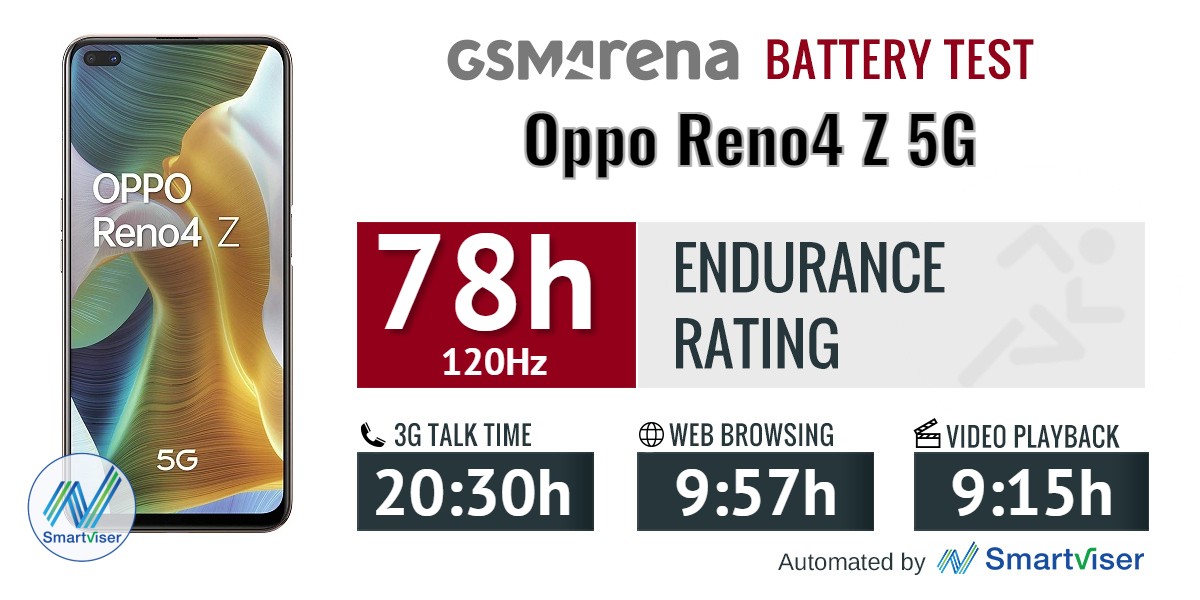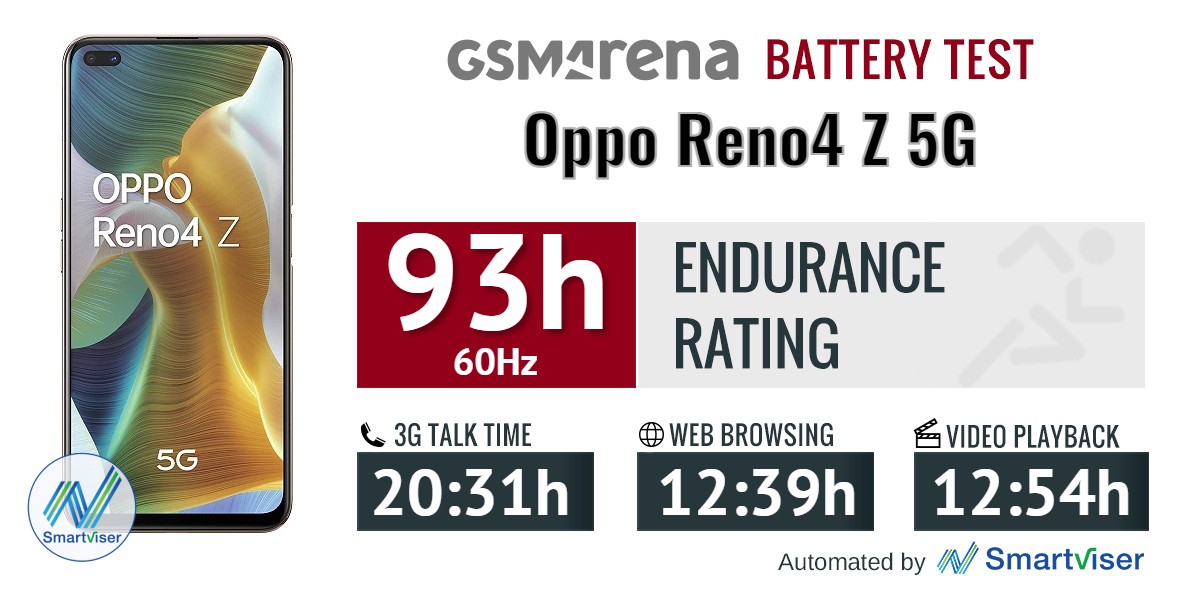Introduction
Oppo just announced the first three of the Reno5 family, and it's likely going to be a large family. How do we know? Well, there are a total of eight Reno4s in our database, and it's one of them that we'll be presenting to you today - the Reno4 Z 5G.

The most affordable of the 5G-enabled 4th-gen Renos, the Z 5G retails for €300 - that's less than half the Reno4 Pro 5G's official asking price and roughly two-thirds of the Reno4 5G's price tag.
The Reno4 Z 5G is powered by a Mediatek Dimensity 800 chipset instead of the Snapdragon 765Gs in the other two. Still, it's not really grounds for concern - a close relative to that SoC, the 800U we got to see recently, performed admirably. Another moderately polarizing bit could be the 6.57-inch LCD. The OLED lovers might scoff at the choice of panel technology, but this one does come with a 120Hz refresh rate. Which brings us to the next point - a 4,000mAh battery with a 120Hz LCD? Sounds a little troubling, but we'll see about that.
Three proper cameras and three sort-of cameras made their way to the Reno4 Z 5G. There's a 48MP primary unit on the back, joined by an 8MP ultra-wide, and then you get a 2MP macro module and a 2MP unit for depth sensing. Another one of those is keeping company to the 16MP selfie camera in a pill-shaped cutout in the display's top left corner.

Oppo Reno4 Z 5G specs at a glance:
- Body: 163.8x75.5x8.1mm, 184g; plastic frame, plastic back.
- Display: 6.57" LTPS IPS LCD, 120Hz, 1080x2400px resolution, 20:9 aspect ratio, 401ppi.
- Chipset: MediaTek MT6873V Dimensity 800 5G (7 nm): Octa-core (4x2.0 GHz Cortex-A76 & 4x2.0 GHz Cortex-A55); Mali-G57 MC4.
- Memory: 128GB 8GB RAM; UFS 2.1.
- OS/Software: Android 10, ColorOS 7.2.
- Rear camera: Wide (main): 48 MP, f/1.7, 26mm, 1/2.0", 0.8µm, PDAF; Ultra wide angle: 8 MP, f/2.2, 119˚, 1/4.0", 1.12µm; Depth: 2x 2 MP, f/2.4.
- Front camera: Wide (main): 16 MP, f/2.0, 26mm, 1/3.06", 1.0µm; Depth: 2 MP, f/2.4.
- Video capture: Rear camera: 4K@30fps, 1080p@30fps, gyro-EIS; Front camera: 1080p@30fps.
- Battery: 4000mAh; Fast charging 18W.
- 5G support: SA/NSA bands 1,3,5,7,8,20,28,38,40,41,77,78.
- Misc: Fingerprint reader (side-mounted); NFC; 3.5mm jack.
Oppo Reno4 Z 5G unboxing
For the 4 Z 5G, Oppo chose the usual Reno presentation - a teal sleeve holds the white cardboard box. The contents are fairly standard, too, though the 18W adapter is a bit on the lower end of the power spectrum - it's certainly no 65W SuperVOOC 2.0. If you can put a positive spin on that, it would be that the USB-A-to-C cable isn't proprietary, unlike on the higher-wattage systems.

Also included is a set of earbuds with a 3.5mm plug - the Reno4 Z 5G is nicely old-school in this respect, unlike the other 2 5G-capable Reno4s. You'll find one more useful accessory in the bundle is a protective case, a transparent silicone one.
Design
The Reno4 Z 5G has one of the more distinct rear camera assemblies around - four modules arranged in a raised up square is nothing new, but the diagonal bump that joins two of those is something unique to this Reno (and to its A92s alter-ego, of course).

That design accent has its roots in the hardware, as only these two diagonally opposed cameras are actual cameras with any thickness requirements - the other two are small 2MP units with limited practical application. They do make for a nice symmetrical design; we'll give them that.

Less appealing is the page of text written on the opposite end of the back panel - a simple Oppo logo would have been easier on the eyes. To be fair, we're not entirely sure what part of those are mandated by which regulatory body where, so Oppo may not have had all that much of a choice.
While it's anything but a cheap phone with its price tag of around €300, the Reno4 Z 5G sits at the lower end of the company's portfolio. Befitting its position then, it gets a rear panel made of plastic. Come to think of it, only the twice as expensive Reno4 Pro 5G gets glass on its back out of all the Reno4s, so the Z 5G isn't treated unfairly.

Our review unit is in the Dew White colorway but white it very rarely is. Most of the time the pearlescent back returns some hue of pink or pale blue at you, depending on how light hits it. Look at it closely, and you'll see layers of very fine striped patterns interweaving below the surface.
The surface itself is frosted, so it's not the smudge magnet that glossy backs can be. On the flipside, it's remarkably slippery so if you're the clumsier type, snap on the included case to gain some extra grip.

There's one more color scheme called Ink Black. We don't know how it looks in person, but the photos we've seen don't present it overly inky.
The frame, too, is made of plastic but is finished to a high-gloss shine with the slightest hint of rose gold. It's rounded and slippery in its own way, so picking up the Reno off a table isn't the easiest of tasks.

The phone relies on a side-mounted capacitive fingerprint reader for biometric authentication. A fairly standard choice for LCD-equipped phones as of late, it's embedded in the power button, placed in a chiseled area on the right side of the handset. It is located a little bit above the midpoint, it's easily reachable with both a right thumb and left index finger and works equally well with either, so it's not discriminatory against smartphone-lefties.

On the opposite side is a pair of volume buttons, discrete ones, that have very positive click action. Further up, towards the top of the left side, is the card slot. The Reno will take one or two nano SIMs in its card tray and zero microSD cards - its storage is non-expandable.


Fingerprint sensor on the right • Volume rocker and card slot on the left
The bottom of the phone is home to the USB-C port, loudspeaker, primary mic, and headphone jack - a classic bottom-of-a-phone arrangement. Up top, a single pinhole hints of a secondary mic.


All the usual stuff on the bottom • A lone mic up top
The 6.57-inch display lights up the front (spoiler, not very brightly). The chin is ever so slightly bigger than what we've grown accustomed to lately - LCD controllers used to be blamed for this when the bezelless craze began, and this is an LCD, after all. The top black border is a bit thicker than the sides, and this is one of those inconsequential details that typically only us reviewers spot on our never-ending quest to find something to whine about.

You can't really miss the pill-shaped cutout for the selfie cameras, however. You look at it and think, 'oh, nice, there's probably an ultra wide camera there'. There isn't, though - joining the real 16MP camera is a 2MP depth sensor, and we're not sure one of those is worth taking up space from the display.

The display is protected by Gorilla Glass 3+, and that's a good thing. Less so is its tendency to accumulate grease. Whatever oleophobic coating the Reno might have, it's not working spectacularly, and having a cloth handy is a good idea if you want a clean screen. In fact, if you keep the factory pre-applied screen protector, this aspect is much better.

The Reno4 Z 5G measures 163.8x75.5x8.1mm making it 0.8mm taller and as much wider than the OnePlus Nord N10 5G. Meanwhile, the Mi 10T Lite 5G is 1.6mm taller and 1.3mm wider. So you could say the Reno has an average footprint for its class. It is tangibly thinner, though - both other handsets above stand at 9mm at their waistlines.
At 184g, the Oppo phone is on the light end of the spectrum, too - the Nord N10 is marginally heavier (190g), but the Xiaomi's a lot heftier at 214g.

Refresh rate is high, brightness - not so much
The Reno4 Z 5G features a 6.57-inch display with a 1080x2400px resolution in a 20:9 aspect ratio for a pixel density of 401ppi. Oppo leaned on the refresh rate side of the OLED vs. HRR scales and fitted a 120Hz LCD - so 'no' to inky blacks, but 'yes' to extra smoothness.

Oppo advertises a maximum brightness of 480nits on the Reno4 Z 5G, the same number as on the Realme 7 5G. Unlike the Realme phone, however, the Reno doesn't manage to live up to the promise and peaks at about 400nits. We also didn't see a boost when the phone is under bright light. Contrast, on the other hand, isn't bad for an LCD at around 1300:1.
| Display test | 100% brightness | ||
| Black, |
White, |
||
| 0.31 | 398 | 1284:1 | |
| 0 | 508 | ∞ | |
| 0 | 843 | ∞ | |
| 0 | 515 | ∞ | |
| 0 | 845 | ∞ | |
| 0.341 | 500 | 1466:1 | |
| 0.53 | 741 | 1398:1 | |
| 0.349 | 443 | 1269:1 | |
| 0.466 | 543 | 1165:1 | |
| 0.315 | 427 | 1356:1 | |
| 0.39 | 522 | 1338:1 | |
| 0.348 | 476 | 1368:1 | |
| 0.455 | 596 | 1310:1 | |
| 0 | 442 | ∞ | |
| 0 | 610 | ∞ | |
| 0.332 | 437 | 1316:1 | |
| 0.376 | 484 | 1287:1 | |
| 0.667 | 571 | 856:1 | |
Color reproduction is handled with a single slider offering stepless adjustment from cool to warm, with the default setting in the middle. In this out of the box state, we measured an average deltaE2000 of 6 when examining sRGB color swatches with whites visibly cold and some 12 units off the mark. Moving the slider all the way to the warmest settings improves things a bit - the average deviation drops to 4.1, and the whitepoint warms up slightly, though it remains bluish and about 8 units off target. Feeding the Reno4 Z 5G DCI-P3 color swatches, we got very similar results for color deviation.
The Reno4 Z 5G supports HDR10, and YouTube and Amazon Prime Video will serve it HDR versions of supported content. Netflix doesn't do HDR on the Reno, though it does offer FullHD resolution. The thing is, with the display being LCD and one of limited brightness at that, HDR isn't as impressive on the Reno as on a good OLED.

With the 120Hz refresh rate capability, the Reno4 Z 5G gets a four-position settings menu for you to pick just the refresh rate you like. The options are 'Auto select,' 120Hz, 90Hz, and 60Hz. Out of these, only the 60Hz setting is straightforward - it locks the refresh rate to 60Hz regardless of the type of content displayed or activity being performed.
The other modes come with numerous exceptions or limitations, but the basics are like this - in 120Hz and in Auto, the phone will maintain 120Hz throughout the UI. The Photos app will be locked in 120Hz in both modes. The Video app will be in 90Hz if you set the phone to 120Hz, but it will be switched all the way down to 60Hz when in Auto. The Camera viewfinder will remain at 60Hz regardless of the display setting. YouTube will switch to 60Hz as soon as you open the app, not just when it's playing back a video - oddly, the Realme 7 5G behaved differently here.
Generally speaking, Auto will be more keen to drop the refresh rate for this app or that, while 120Hz will stick to 120Hz more often than not, though it will still drop it depending on the app you launch - the Settings menu do point that out, so there's no attempt to fool you here. The 90Hz setting will behave similarly to 120Hz, only capped at 90Hz, obviously.
As for games, much like every other Oppo or Realme we've had at the office, no game goes above 60Hz/60fps on the Reno4 Z 5G.
Oppo Reno4 Z 5G battery life
The Reno4 Z 5G has a 4,000mAh battery inside - that used to pass for a large capacity, but with the advent of 5G and high-refresh rates, it's more or less the norm at the end of 2020.
In our testing, the phone was good for a little over 20 hours of voice calls - not spectacular, but perfectly acceptable. The standby performance was pretty great, however.
We carried out our on-screen tests in both 60Hz and forced 120Hz modes to give you an idea of best-case and worst-case scenarios. At forced 120Hz, you'd be looking at an appalling 9:15h video playback runtime and 10h of Wi-Fi Web browsing.
Mind you, while the phone will auto switch to 60Hz for video playback in most apps, it will stay in 120Hz for video in the default in-house gallery app (called Photos), so we figured this 'worst case' is indeed something we should look into.

With the display set at 60Hz, we clocked tangible improvements in both screen-on tests. Web browsing shot up to 12:39h and video playback longevity increased to 12:54h. In practice, if you stay away from the Photos apps for video playback - there's a Videos app for that, after all - you can expect to get results in between the two scorecards as the video will gravitate towards the 60Hz number. At the same time, web browsing will be closer to the 120Hz result.

Our battery tests were automated thanks to SmartViser, using its viSerDevice app. The endurance rating above denotes how long a single battery charge will last you if you use the Oppo Reno4 Z 5G for an hour each of telephony, web browsing, and video playback daily. We've established this usage pattern so that our battery results are comparable across devices in the most common day-to-day tasks. The battery testing procedure is described in detail in case you're interested in the nitty-gritty. You can check out our complete battery test table, where you can see how all of the smartphones we've tested will compare under your own typical use.
Battery charging
The Reno4 Z 5G ships with a plain 18W charger that says 5V/2A and 9V/2A on it, so we're guessing it's probably something of a QuickCharge 2.0/3.0 equivalent, though it's not stated explicitly anywhere. The phone is far from its record-setting stablemates and takes almost 2 hours to a full charge from flat, with 35% showing in the battery indicator at the half-hour mark.
30min charging test (from 0%)
- Oppo Reno4 Pro
98% - Oppo Reno4 Pro 5G
97% - Xiaomi Mi 10T Lite 5G
68% - vivo V20
66% - OnePlus Nord N10 5G
65% - Realme 7 5G
57% - Huawei P Smart 2021
42% - Samsung Galaxy A51 5G
39% - Oppo Reno4 Z 5G
36% - Samsung Galaxy A51
35% - Motorola Moto G 5G Plus
35%
Time to full charge (from 0%)
- Oppo Reno4 Pro
0:31h - Oppo Reno4 Pro 5G
0:32h - OnePlus Nord N10 5G
0:52h - Xiaomi Mi 10T Lite 5G
0:58h - vivo V20
0:59h - Realme 7 5G
1:06h - Samsung Galaxy A51 5G
1:30h - Huawei P Smart 2021
1:42h - Oppo Reno4 Z 5G
1:55h - Motorola Moto G 5G Plus
2:10h - Samsung Galaxy A51
2:14h
Speaker test
The Reno4 Z 5G has a single speaker firing out of the bottom of the phone. It's fairly quiet and earned an 'Average' rating in our test, barely missing the 'Good' category, which the Realme 7 5G managed to get to. It delivers clear vocals and colorful highs, but there's little in the way of low-frequency thump.

Stereo speakers can be found for the money - on the Mi 10T Lite 5G and the Moto G8 Power, for example, and those are also louder. That Moto doesn't have 5G, though, while the Moto G 5G Plus is mono, quieter too.
Use the Playback controls to listen to the phone sample recordings (best use headphones). We measure the average loudness of the speakers in LUFS. A lower absolute value means a louder sound. A look at the frequency response chart will tell you how far off the ideal "0db" flat line is the reproduction of the bass, treble, and mid frequencies. You can add more phones to compare how they differ. The scores and ratings are not comparable with our older loudspeaker test. Learn more about how we test here.
Audio output quality
We've recently discontinued our audio output quality test.
The reason for that is that most phones that arrived for testing were already excellent in this regard. Whatever difference there was, it was marginal and probably indistinguishable to anything but our lab equipment.
ColorOS is a step behind in v7.1, Android is 10
The Reno4 Z 5G runs ColorOS 7.1 - that's 0.1 less than the majority of recent Oppos, including the Reno4 Pro and Reno4 Pro 5G. Hardly a dealbreaker since there's not much difference between the two, but it just goes to show that the Z might be a little slower to get updates. It's still Android 10 that's underneath the in-house UI layer.

The homescreen situation is predictable - you get to choose between the simplified approach with all the apps arranged on the homescreens or the two-tiered homescreen + app drawer way. The UI basics are entirely ordinary.






Lockscreen • Homescreen • Folder view • App Drawer • Quick toggles and notifications • Task switcher
We found no theme store on this unit, and there was just a single theme pre-installed, so customization isn't great in this respect. The app icons themselves, on the other hand, are highly customizable.






Homescreen settings • Homescreen settings • Homescreen mode • Swipe down options • A theme • Icon settings
Navigation options are aplenty too. The standard Android 10 navigation, which employs the side edges for going Back while upward swipes from the bottom take you Home, is called Swipe Gestures from Both Sides in ColorOS, and that would be our top choice.
Color OS has a gesture for a quick switch between the last two apps if you swipe in for Back, but hold for a brief instant. That's optional, and it can work in addition to the default side swiping on the bottom of the screen.
A classic three-button navigation bar is available if you're old school like that, and it lets you choose between two layouts. There's also a More option, which will take you to the Swipe-up gestures alternative - the middle option between the navbar and real gestures.
The Smart Sidebar feature we've seen on other ColorOS builds is here too. A swipe in from the side opens a toolbar with actions and shortcuts. You can customize them and also adjust the bar's position and opacity.






Navigation options • Smart sidebar
The Reno4 Z 5G's display supports a 120Hz refresh rate, and you get a four-way setting between 120Hz, 90Hz, 60Hz, and Auto. As we detailed on the previous page, that setting is only ever set in stone if you have it at the 60Hz position, with the other modes adjusting it to optimize the experience.
There's a system-wide dark mode, and it can be engaged permanently or according to a schedule. It'll invoke supported apps' dark themes, but you can also enforce dark mode on third-party apps that don't have it built-in. There is no Always-on display on the Reno4 Z 5G.






Refresh rate settings • Dark mode
Unlocking the Reno4 Z 5G is best done using the capacitive fingerprint sensor on the right. As far as this type of implementation goes, the one on the Reno is among the better ones - it didn't discriminate between the left index finger and right thumb and unlocked swiftly and consistently. If, however, you find yourself suffering from a common inherent flaw of such fingerprint readers - accidental touches with any part of your hand triggering it, you can have it engage with a press on the button, which is otherwise not required.
Basic face recognition is available too. It uses just the selfie cam (so no fancy 3D scanning) and isn't as secure as the fingerprint reader, but it's fast and convenient. The phone can be set to require at least one open eye for added security.
Drawing letters on a turned-off screen remains a staple of ColorOS, and it is present on the Reno4 Z 5G as well. As usual, the torch and the camera app are probably the most useful assignments. In this version of ColorOS, you cannot launch the camera with a double press on the volume buttons as you can on ColorOS 7.2, so the screen off gesture remains a viable option.
The multimedia apps such as Photos, Music, and Videos are provided by Oppo. There's a File Manager, a Phone Manager, and a few other tools pre-installed, including a custom calculator and a voice recorder. As has been the trend with recent handsets by the company, the replacement of the in-house Phone and Messages apps for Google's own has made its way to the Reno4 Z 5G too.






Gallery • Videos • File Manager • Phone Manager • Calculator • Voice recorder
Synthetic benchmarks
The Dimensity 800 is in charge of doing the calcs on the Reno4 Z 5G, a Mediatek midrange SoC that also goes by MT6873V. Only a U separates it from the 800U that we saw on the Realme 7 5G just a couple of weeks ago, but that U makes quite the difference in the core configuration, in fact.
The Dimensity 800 we have here has 4 Cortex-A76 cores and 4 Cortex-A55 ones, compared to the 2xA76 + 6xA55 arrangement in the Dimensity 800U. On the other hand, the beefy A76s are capped at 2.0Ghz on this one, while they can go as high as 2.4GHz on the U. A similar core count vs. clock rate trade-off can be seen in the GPU department; otherwise, the same Mali-G57 base design - the 800U uses three cores, the 800 here in the Reno has four.
The Oppo Reno4 Z 5G is only available in a single memory configuration with 8GB of RAM and 128GB of storage.

In the CPU-focused GeekBench, we see the first difference between the two Dimensities quite clearly - the Reno trails in single-core performance on account of its relatively low clock speed. Still, it captures the lead in multi-core results thanks to the many high-performance cores. The Reno is also superior to the Snapdragon 765 bunch under multi-core loads by a healthy margin, though it doesn't compare favorably in single-core tasks.
GeekBench 5 (multi-core)
Higher is better
- Oppo Reno4 Z 5G
2196 - Xiaomi Mi 10T Lite
2009 - OnePlus Nord
1953 - Xiaomi Mi 10 Lite 5G
1927 - Motorola Moto G 5G Plus
1898 - Galaxy A51 5G
1867 - OnePlus Nord N10 5G
1848 - Oppo Reno4 Pro 5G
1805 - Realme 7 5G
1794 - Poco X3 NFC
1777 - Motorola Moto G8 Power
1394
GeekBench 5 (single-core)
Higher is better
- Galaxy A51 5G
677 - Xiaomi Mi 10T Lite
661 - Xiaomi Mi 10 Lite 5G
616 - Oppo Reno4 Pro 5G
615 - OnePlus Nord
610 - OnePlus Nord N10 5G
608 - Realme 7 5G
598 - Motorola Moto G 5G Plus
589 - Poco X3 NFC
568 - Oppo Reno4 Z 5G
522 - Motorola Moto G8 Power
311
In Antutu, the Reno doesn't strictly impress either, though it's not as far behind the SD765s as in the single-core CPU test.
AnTuTu 8
Higher is better
- Xiaomi Mi 10T Lite
318882 - Realme 7 5G
318535 - Xiaomi Mi 10 Lite 5G
318117 - Oppo Reno4 Pro 5G
317139 - Galaxy A51 5G
316007 - OnePlus Nord
312794 - Motorola Moto G 5G Plus
299926 - Oppo Reno4 Z 5G
295562 - Poco X3 NFC
283750 - OnePlus Nord N10 5G
279579 - Samsung Galaxy A51
175363 - Motorola Moto G8 Power
173607
When it comes to graphics, the Reno4 Z 5G doesn't pull ahead of the Realme 7 5G in GFXBench despite having an extra core - hence our speculation that the GPU cores in the Dimensity 800 are clocked lower. The two phones are mostly on par and produce results comparable to the handsets using the SD765 with Adreno 620 GPU - so about as good as graphics get in the midrange. The Galaxy A51 5G, packing an Exynos 980 is ever so slightly behind, while the non-5G A51 is substantially slower, as expected of its modest SoC.
GFX Manhattan ES 3.1 (offscreen 1080p)
Higher is better
- Xiaomi Mi 10 Lite 5G
38 - OnePlus Nord
38 - Oppo Reno4 Pro 5G
37 - Realme 7 5G
35 - Oppo Reno4 Z 5G
34 - Xiaomi Mi 10T Lite
33 - Poco X3 NFC
33 - Motorola Moto G 5G Plus
33 - Galaxy A51 5G
32 - OnePlus Nord N10 5G
26 - Motorola Moto G8 Power
13
GFX Manhattan ES 3.1 (onscreen)
Higher is better
- OnePlus Nord
34 - Xiaomi Mi 10 Lite 5G
32 - Realme 7 5G
31 - Oppo Reno4 Pro 5G
31
29
29
28
28
27
23
12
GFX Car Chase ES 3.1 (offscreen 1080p)
Higher is better
- Xiaomi Mi 10 Lite 5G
21 - OnePlus Nord
21 - Oppo Reno4 Pro 5G
21 - Realme 7 5G
20 - Oppo Reno4 Z 5G
20 - Galaxy A51 5G
20 - Xiaomi Mi 10T Lite
19 - Poco X3 NFC
19 - Motorola Moto G 5G Plus
19 - OnePlus Nord N10 5G
14 - Motorola Moto G8 Power
7.1
GFX Car Chase ES 3.1 (onscreen)
Higher is better
- OnePlus Nord
19 - Oppo Reno4 Pro 5G
18 - Realme 7 5G
17 - Xiaomi Mi 10 Lite 5G
17 - Galaxy A51 5G
17 - Oppo Reno4 Z 5G
16 - Xiaomi Mi 10T Lite
16 - Poco X3 NFC
16 - Motorola Moto G 5G Plus
16 - OnePlus Nord N10 5G
13 - Motorola Moto G8 Power
6.6
Aztek Vulkan High (onscreen)
Higher is better
- OnePlus Nord
13 - Xiaomi Mi 10 Lite 5G
12 - Oppo Reno4 Pro 5G
12 - Realme 7 5G
11 - Oppo Reno4 Z 5G
11 - Xiaomi Mi 10T Lite
11 - Poco X3 NFC
11 - Motorola Moto G 5G Plus
11 - Galaxy A51 5G
9.9 - OnePlus Nord N10 5G
8.7
GFX Aztek ES 3.1 High (onscreen)
Higher is better
- OnePlus Nord
13 - Realme 7 5G
12 - Oppo Reno4 Z 5G
12 - Xiaomi Mi 10 Lite 5G
12 - Oppo Reno4 Pro 5G
12 - Galaxy A51 5G
12 - Xiaomi Mi 10T Lite
11 - Poco X3 NFC
11 - OnePlus Nord N10 5G
5.7
In fact, in 3D Mark, the Reno4 Z 5G actually takes the lead of this esteemed mid-tier group, both in the OpenGL test and in Vulkan.
3DMark SSE ES 3.1 (offscreen 1440p)
Higher is better
- Oppo Reno4 Z 5G
3308 - Xiaomi Mi 10 Lite 5G
3294 - Oppo Reno4 Pro 5G
3288 - OnePlus Nord
3285 - Realme 7 5G
3163 - Motorola Moto G 5G Plus
3031 - Galaxy A51 5G
2837 - Xiaomi Mi 10T Lite
2789 - Poco X3 NFC
2689 - OnePlus Nord N10 5G
2166 - Samsung Galaxy A51
1574
3DMark SSE Vulkan 1.0 (offscreen 1440p)
Higher is better
- Oppo Reno4 Z 5G
3180 - Xiaomi Mi 10 Lite 5G
3080 - OnePlus Nord
3067 - Oppo Reno4 Pro 5G
3062 - Realme 7 5G
3028 - Motorola Moto G 5G Plus
2821 - Galaxy A51 5G
2778 - Xiaomi Mi 10T Lite
2595 - Poco X3 NFC
2495 - OnePlus Nord N10 5G
2012 - Samsung Galaxy A51
1554
The Reno4 Z 5G is more than adequately powered thanks to the Mediatek Dimensity 800 chipset. The only setback is its lower-than-average single-core CPU performance, but in both multi-core tasks and GPU-related loads, the Reno is about as good as any Snapdragon 765 powered midranger.
3 real cameras, 3 more just for show?
The Reno4 Z 5G is equipped with a quad-camera setup on its back. However, as we've seen on many other budget offerings, only two of these are actual cameras - the other two are there mostly to make it look like the phone has many cameras.

The first real camera, the 48MP main unit, is about as mainstream as they come - it uses a Sony IMX 586 Quad Bayer sensor with 0.8µm pixels and 12MP default image size after the 4-to-1 binning. It is coupled with a lens that has a 26mm equivalent focal length with an f/1.7 aperture.
The second camera that takes pictures you can see is an 8MP ultra wide-angle unit. Oppo says it's got a lens that covers a 119-degree field of view (around 13mm equivalent focal length), but it applies distortion correction (which you can't turn off), and then the FoV drops to 109 degrees (15-ish mm equivalent). The aperture on this one is f/2.2.
Then you have a couple of portrait cameras, 2MP each. Oppo details these as "black-and-white portrait monochrome lens" and "vintage portrait monochrome lens," whatever any of that means. Some phones at least call one of these 2MP cameras 'macro' and let you access and use it, but not here.
Over on the front, in a pill-shaped cutout in the display, you have a 16MP selfie camera with an f/2.2 aperture lens and an extra "depth of field secondary lens." There, that's 3+3.

The camera app is the same one you'd find across all Oppos and Realmes. Most of the modes are on the main rolodex with side swipes in the viewfinder switching between them, one at a time. You can slide on the mode 'dial' to flip through multiple modes at a time too. Modes deemed less important can be found in an additional 'More' pane at the far right. A Dazzle Color toggle in the middle of the icon array in the viewfinder engages a color boost.
There's an Expert mode where you get to tweak exposure (ISO in the 100-64000 range and shutter speed in the 1/8000s-32s range), white balance (by light temperature, but no presets), manual focus (in arbitrary 0 to 1 units with 0 being a close focus and 1 being infinity) and exposure compensation (-2EV to +2EV in 1/6EV increments). These expert controls are only available for all three cams, switched from the tree icon on the viewfinder's far end.
Daylight image quality
The Reno4 Z 5G takes okay photos with its main camera - not great, not terrible. Dynamic range isn't spectacular, but it's not bad for the class either. Colors are lively without being over the top, and if the samples are looking a bit on the warm side, it's the afternoon sun more so than a particular tendency of the phone to mess up the white balance.
Detail levels are on par with what you can expect from any 12MP camera, but the way the Reno renders fine textures or sharp edges isn't particularly pleasing. Sharpening is rather heavy-handed, making grass and leaves look very artificial. There's also a fair bit of aliasing to slanted straight lines. A little noise can be spotted too, but we wouldn't call it prominent by any stretch.








Daylight samples, main cam (1x)
The Dazzle Color toggle in the viewfinder gives colors a slight boost, but it's not as dazzling as on other Oppos or Realmes we've seen - we appreciate the more measured approach on this one. We'd even prefer this mode for November and December when nature looks particularly drab where we reside.






Daylight samples, main cam (1x), Dazzle Color on
The 48MP mode is available but isn't overly useful - its results look nearly identical to what you'd get if you upscale the 12MP images to 48MP and apply a little sharpening.



Daylight samples, main cam (1x), 48MP
It's no wonder then that the 2x digital zoom doesn't look particularly great at pixel level either. However, the images will do at fit to screen magnification, though a simple crop from the main camera's shots will serve the same purpose.



Daylight samples, main cam (2x)
The ultra wide-angle cam on the Reno4 Z 5G, being an unpretentious 8MP unit, delivers relatively low levels of absolute detail, and with some noise to top it off. Dynamic range isn't bad for an ultra-wide, and the colors are quite likable, so it's not all bad.






Daylight samples, ultra wide cam
Low-light image quality
Low-light photos out of the Reno4 Z 5G continue along the same 'average' path. Its main cam captures decent detail in the well-lit areas though shadows can be mushy and noisy. The phone tends to expose relatively bright, which we appreciate, even if it can result in blown highlights around point light sources. We observed no white balance issues with warm street lights, an all too common occurrence.






Low-light samples, main cam (1x)
Night mode will salvage the highlights, that much is true, and it will also improve sharpness in the deeper shadows, though the well-lit areas will actually be a bit softer than in photo mode. The aggressive highlight retention can make these images look flat and a little dark. Other phones tend to work on the tonal extremes without sacrificing contrast quite as much.






Low-light samples, main cam (1x), Night mode
The ultra-wide cam doesn't enjoy the night one bit and can't gather enough light for proper exposure in most dark scenes. Its results range from dark and soft in darker scenes to decently exposed but noisy in better lit scenarios, with a narrow dynamic range in either case.






Low-light samples, ultra wide cam
Night mode won't do miracles for the darkest of scenes, but it will help out immensely in more reasonable scenarios. You can expect much better-developed shadows and improved sharpness overall.






Low-light samples, ultra wide cam, Night mode
Once you're done with the real world samples, head over to our Photo compare tool to see how the Oppo Reno4 Z 5G stacks up against the competition.



Oppo Reno4 Z 5G against the Mi 10T Lite 5G and the Realme 7 5G in our Photo compare tool
Portrait mode
The Reno4 Z 5G takes really good faux bokeh portraits. It isolates the subject well, makes no blunders with clothes outlines, and does a good job with scenes of varying depth. As usual, a messy hairstyle against a contrasting background could make for unnaturally blurry results.
Similarly, successful results can be expected with non-human subjects as well. So the 2MP depth cameras are not entirely useless, after all.



Portrait mode samples, non-human subjects
Selfies
The Reno4 Z 5G takes good selfies in balanced lighting where you have a well-lit subject and no backlighting (sample 1 below). There's some noise to be seen even in these ideal conditions at low ISO, but there's also fine detail on the subject and nicely natural processing.
With dimmer lighting or more challenging contrasty scenes, the results aren't nearly as good on a pixel level, and you can see the combined effects of high ISO noise reduction and excessive sharpening taking a significant toll on your detail.
On a global scale, colors are a bit muted and could use a nudge in the saturation department, but we have no grounds to complain about dynamic range.
Front camera portraits show fairly good subject detection across most scenes, though these are a little more prone to errors than what we witnessed on the back camera. Additionally, these get a slight crop from the selfie cam's native focal length, but at then upscaled to match the 16MP resolution, so they get a little bit softer still than the regular selfies, themselves not great examples of sharpness to begin with.




Selfie samples, Live focus (Portrait) mode
Video recording
The Reno records video up to 4K30 with its main cam and 1080p30 with the ultra-wide - there are no 60fps modes in 1080p on either cam. You get to choose between the h.264 and h.265 codec, and that's about all the video settings at your disposal.
The Reno4 Z 5G's 4K videos are sharp and reasonably detailed though we've seen finer textures in other phones' footage. Dynamic range is about average, and color reproduction is a bit more restrained than in photos, though not as far as to be called muted.
The ultra-wide cam's footage is best described as usable. On the soft side, the dynamic range is so-so, and the colors could use a boost.
Stabilization on the main cam is quite effective at removing camera shake and handling pans without abrupt transitions. If you're shooting while walking, the shake, combined with some focus hunting, could result in some slightly annoying wobble, but your mileage may vary. There's no stabilization on the ultra-wide camera.
Here's a glimpse of how the Oppo Reno4 Z 5G compares to rivals in our Video compare tool. Head over there for the complete picture.



Oppo Reno4 Z 5G against the Mi 10T Lite 5G and the Realme 7 5G in our Video compare tool
Competition
The way we're seeing the Reno4 Z 5G's market position, it's the company's entry into the affordable 5G handset market - €300 can pass for 'affordable' when 5G is involved. That's a growing market, and one that we've already had a bit of experience with.

Most recently, we had the Mi 10T Lite 5G over (another mouthful of a name). Another 120Hz LCD, this one offers finer refresh rate control and it can actually go above 60fps in at least some games, plus its screen can shine brighter than the Reno's. The Xiaomi has stereo speakers, a microSD slot, and even an infrared emitter, plus it charges faster on top of its already significantly better battery life. With the two retailing at the same price, it's really no contest.
The Realme 7 5G is a close relative of the Reno4 Z 5G and comes at a marginally lower price. Even so, it has a few small advantages like the macro cam, memory slot, and faster charging, but more importantly, it's got a higher-capacity battery and better endurance. The Reno does perhaps take superior portrait photos for what that's worth.
The OnePlus Nord N10 5G is another cousin to the Reno and the Realme, and it's the most expensive of the three, with a list price of €350. The price premium won't get you a better display (it tops out at 90Hz and it's not very bright either) or a faster chipset (the N10's Snapdragon 690 isn't as powerful as the Reno's Dimensity 800). Going Nord, however, you will get longer battery life and faster charging, much nicer stereo speakers, and a microSD slot, plus generally better image quality.
Not a very popular phone, but one that is well worthy of a mention in this context is the Moto G 5G Plus. The Moto has a nice 5MP macro cam, but outside of that, the Reno4 Z 5G has a superior rear camera. However, the Moto counters with an actually useful ultra-wide secondary selfie cam instead of the Reno's 2MP depth sensor. The Moto lasts longer on a charge and has a brighter display too, plus it's got a memory slot and an FM radio.




Xiaomi Mi 10T Lite 5G • Realme 7 5G • OnePlus Nord N10 5G • Motorola Moto G 5G Plus
Verdict
If 5G is really important to you now or as some kind of future-proofing, and you're operating on a budget, perhaps the Reno4 Z 5G makes sense. After all, it is one of the more affordable handsets with next-gen connectivity available on a more or less global scale.

To make 5G fit the budget, Oppo has apparently compromised on a few of the important bits like display and battery life, and we're not entirely okay with that. Sure, the display has a high refresh rate, but it sacrifices max brightness in the process. Battery life, too, is lagging behind the competition, as is charging speed. The camera system isn't bad per se, but doesn't really stand out in any meaningful way. All things considered, if it was our money, we'd look at something other than the Reno4 Z 5G.
Pros
- Affordable 5G handset
- Super smooth 120Hz LCD
- Capable, brand new chipset by Mediatek
- Great Portrait mode photos
Cons
- Display doesn't get very bright, HRR not available in games
- Below average battery endurance, relatively slow charging
- Overall camera quality is not spectacular
























0 Response to "Oppo Reno4 Z 5G review"
Post a Comment